
Fremontodendron, with the common names fremontia, flannelbush, and flannel bush, is a genus of three known species of shrubs native to the Southwestern United States and northwest Mexico.

Paulownia tomentosa, common names princess tree, empress tree, or foxglove-tree, is a deciduous hardwood tree in the family Paulowniaceae, native to central and western China. It is an extremely fast-growing tree with seeds that disperse readily, and is a persistent exotic invasive species in North America, where it has undergone naturalisation in large areas of the Eastern US. P. tomentosa has also been introduced to Western and Central Europe, and is establishing itself as a naturalised species there as well.

Pandanus tectorius is a species of Pandanus (screwpine) that is native to Malesia, eastern Australia, and the Pacific Islands. It grows in the coastal lowlands typically near the edge of the ocean. Common names in English include thatch screwpine, Tahitian screwpine, hala tree and pandanus. The edible fruit is sometimes known as hala fruit.
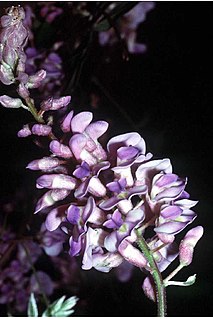
Wisteria frutescens, commonly known as American wisteria, is a woody, deciduous, perennial climbing vine, one of various wisterias of the family Fabaceae. It is native to the wet forests and stream banks of the southeastern United States, with a range stretching from the states of Virginia to Texas and extending southeast through Florida, also north to Iowa, Michigan, and New York.
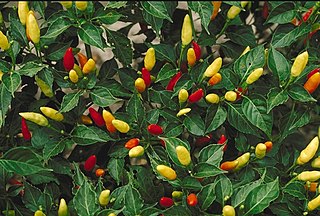
Capsicum frutescens is a wild chili pepper having genetic proximity to the cultivated pepper Capsicum sinense native to Central and South America. Pepper cultivars of C. frutescens can be annual or short-lived perennial plants. Flowers are white with a greenish white or greenish yellow corolla, and are either insect- or self-pollinated. The plants' berries typically grow erect; ellipsoid-conical to lanceoloid shaped. They are usually very small and pungent, growing 10–20 millimetres (0.39–0.79 in) long and 3–7 millimetres (0.12–0.28 in) in diameter. Fruit typically grows a pale yellow and matures to a bright red, but can also be other colors. C. frutescens has a smaller variety of shapes compared to other Capsicum species. C. frutescens has been bred to produce ornamental strains because of its large quantities of erect peppers growing in colorful ripening patterns.

Vachellia farnesiana, also known as Acacia farnesiana, and previously Mimosa farnesiana, commonly known as sweet acacia, huisache, or needle bush, is a species of shrub or small tree in the legume family, Fabaceae. It is deciduous over part of its range, but evergreen in most locales. The species grows to a height of 15–30 feet (4.6–9.1 m) and grows multiple trunks. The base of each leaf is accompanied by a pair of thorns on the branch. Its flowers are used in the perfume industry.

Sanguisorba minor, the salad burnet, garden burnet, small burnet, burnet, pimpernelle, Toper's plant, and burnet-bloodwort, is an edible perennial herbaceous plant in the family Rosaceae. It has ferny, toothed-leaf foliage; the unusual crimson, spherical flower clusters rise well above the leaves on thin stems. It genrally grows to 25–55 cm tall. The large, long, taproots store water, making it drought-tolerant.

Leucophyllum is a genus of evergreen shrubs in the figwort family, Scrophulariaceae, native to the southwestern United States and Mexico. It is sometimes placed in the family Myoporaceae. The dozen-odd species are often called "sages", although they have no relationship to the genus Salvia.
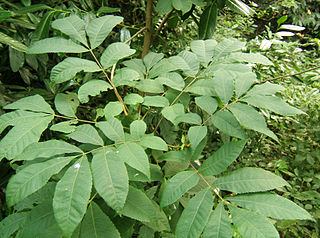
Carya cordiformis, the bitternut hickory, also called bitternut or swamp hickory, is a large pecan hickory with commercial stands located mostly north of the other pecan hickories. Bitternut hickory is cut and sold in mixture with the true hickories. It is the shortest-lived of the hickories, living to about 200 years.

Tecoma stans is a species of flowering perennial shrub in the trumpet vine family, Bignoniaceae, that is native to the Americas. Common names include yellow trumpetbush, yellow bells, yellow elder, ginger-thomas. Tecoma stans is the official flower of the United States Virgin Islands and the floral emblem of The Bahamas.

Verbena bonariensis, the purpletop vervain, clustertop vervain, Argentinian vervain, tall verbena or pretty verbena, is a member of the verbena family cultivated as a flowering annual or herbaceous perennial plant. In USA horticulture, it is also known by the ambiguous names purpletop and South American vervain. For the misapplication "Brazilian verbena" see below.

Alhagi maurorum is a species of legume commonly known, variously, as camelthorn, camelthorn-bush, Caspian manna, and Persian mannaplant. This shrub is native to the region extending from the Mediterranean to Russia, but has been introduced to many other areas of the world, including Australia, southern Africa, and the western United States. The perennial plant grows from a massive rhizome system which may extend over six feet into the ground. New shoots can appear over 20 feet from the parent plant. Above the ground, the plant rarely reaches four feet in height. It is a heavily branched, gray-green thicket with long spines along the branches. It bears small, bright pink to maroon pea flowers and small legume pods, which are brown or reddish and constricted between the seeds. The seeds are mottled brown beans.

Mesembryanthemum crystallinum is a prostrate succulent plant native to Africa, Sinai and southern Europe, and naturalized in North America, South America and Australia. The plant is covered with large, glistening bladder cells or water vesicles, reflected in its common names of common ice plant, crystalline ice plant or ice plant.
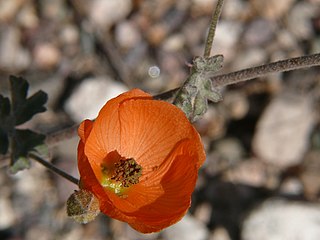
Sphaeralcea ambigua, is a species of flowering plant commonly known as desert globemallow or apricot mallow, is a member of the genus Sphaeralcea in the mallow family (Malvaceae).

Salix atrocinerea, commonly called grey willow or large gray willow, is a species of willow. It is a bush or small tree up to 12 m (39 ft) tall. As a pioneer species of willow, it quickly colonizes poor soils.

Argyranthemum frutescens, known as Paris daisy, marguerite or marguerite daisy, is a perennial plant known for its flowers. It is native to the Canary Islands. Hybrids derived from this species are widely cultivated as ornamental plants in private gardens and public parks in many countries, and have naturalized in Italy and southern California. There are many cultivars, but the most common has white petals.

Tephrosia vogelii, the Vogel's tephrosia, fish-poison-bean or Vogel tephrosia (English), tefrósia (Portuguese) or barbasco guineano (Spanish), is a flowering plant species in the genus Tephrosia.

Mimosa aculeaticarpa is a species of woody shrub in the family Fabaceae. It is commonly known as the catclaw mimosa or the wait-a-minute bush, and is endemic to upland regions of Mexico and the Southwestern United States, particularly Arizona, New Mexico and Texas.
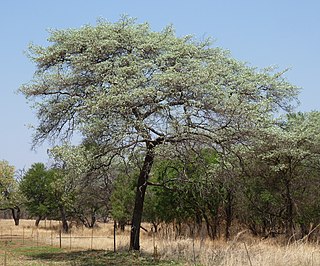
Terminalia sericea is a species of deciduous tree of the genus Terminalia that is native to southern Africa. Its common names include clusterleaf, silver cluster-leaf or silver terminalia in English, vaalboom in Afrikaans and mususu in Venda.
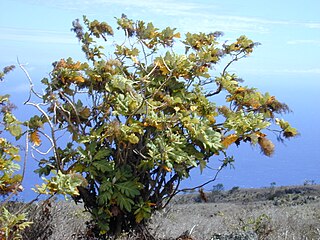
Bocconia frutescens is a species of flowering plant in the poppy family known by many common names, including plume poppy, tree poppy, tree celandine, parrotweed, sea oxeye daisy, and John Crow bush in English, gordolobo, llorasangre, tabaquillo, palo amarillo, palo de toro and pan cimarrón in Spanish, and bois codine in French. It is native to the Americas, including Mexico, parts of Central and South America, and the West Indies. It is perhaps better known in Hawaii, where it is an introduced species and an aggressive invasive weed with rapid negative effects on local ecosystems. In other parts of the United States it is used as an ornamental plant for its "tropical"-looking foliage.




















